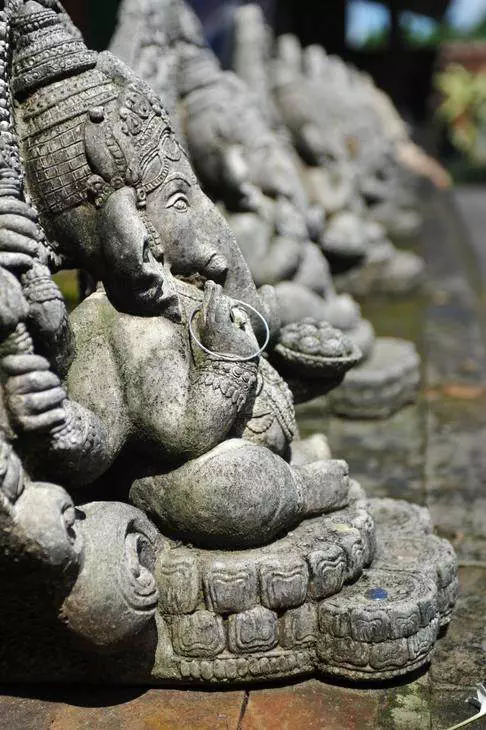
The first time I heard of Ganesh, I was in a Buddhist temple somewhere in Korea wondering why there was an elephant-shaped statue. In my ignorance, I shrugged, snapped a couple of pictures, and moved on — never really learned the back story behind one of the widely worshipped Hindu deities. This is the place to come to do some of that learning.

Since this is Worthy Go and not Religious Icons Monthly, there has to be at least a little quirkiness to the place. I get the ‘no talking on the phone’ one, but the Ghostbusters one?
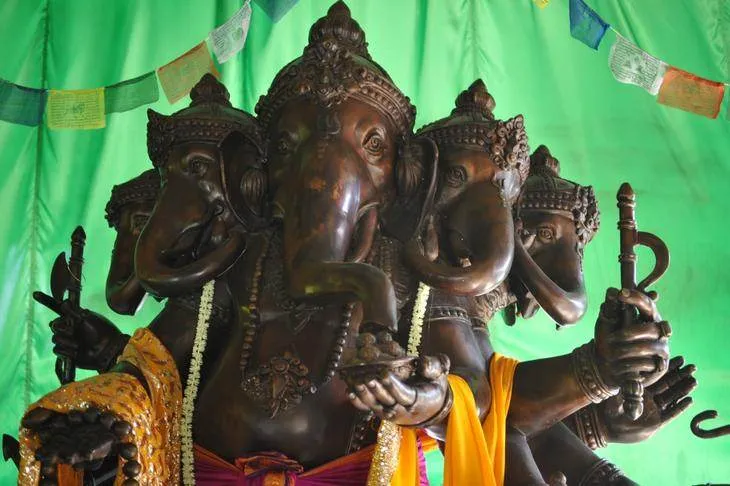
Heramba-Ganapati, one of Ganesh’s more popular forms with five heads. Even after visiting the site, I won’t pretend to understand all the symbolism found within the various statues. In a paragraph, however, I can tell you Ganesh is seen as a remover of obstacles, a patron of the arts and sciences, and the deva of intellect and wisdom. Ganesh is revered as the god of beginnings, and thus is honored at the start of rituals and ceremonies. First worshipped in the 4th or 5th century, images of Ganesha were common in India in the 6th century.
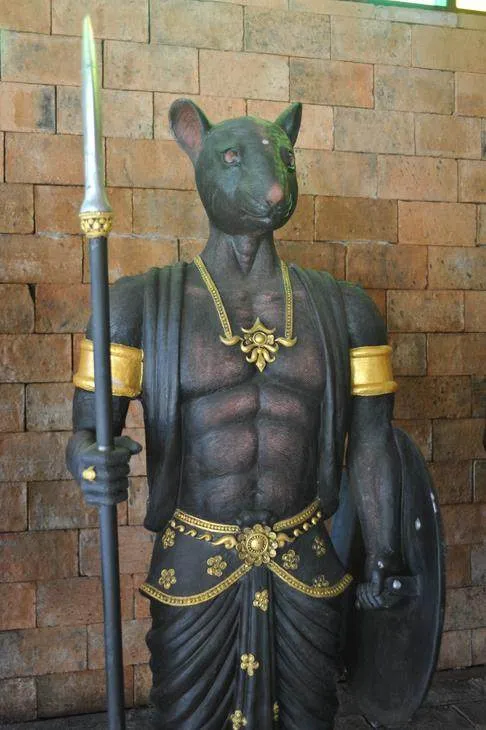
Lest you think the lowly rat has no place here, the tales around Ganesh often have him riding or being attended to by a rat / mouse. The Sanskrit word for mouse (mūṣaka) is derived from stealing or robbing (mūṣ). Showing the rat as his servant or attendant implies Ganesh’s power or ability to overcome obstacles.
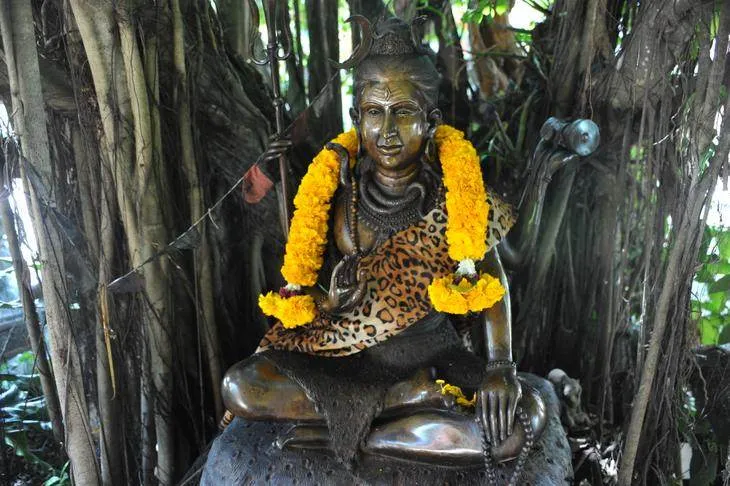
And then there’s Shiva — if you paid any attention while watching Indiana Jones and the Temple of Doom, you might remember Shiva referred to as the great destroyer and transformer (you’re probably wondering if you have the movie right now). Ganesh is Shiva’s son, in case you were curious about the connection.

Buddhist prayer flags flapping around in the wind.
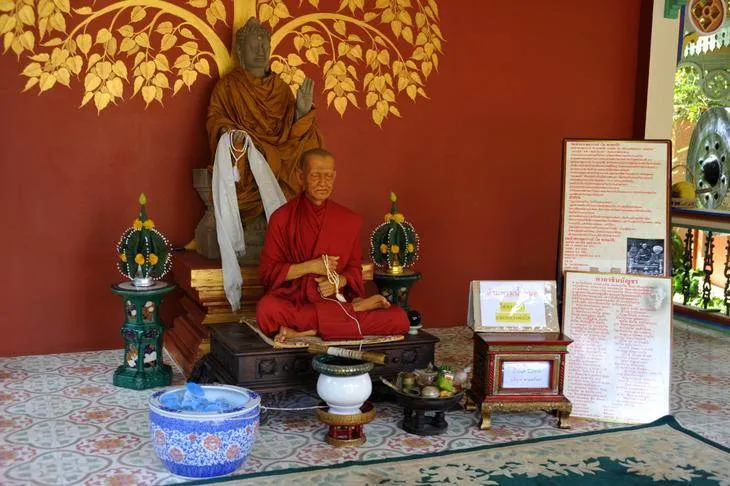
An honored monk — while all the details are in Thai, I can tell you he was born in 2331 BE (Buddhist Era — that’s 1788 to you Gregorian calendar followers), become a monk at 20 years old, and served for 64 years until his death in 2415 BE (1872).
The next section is both more interesting, and unfortunately a no photo zone. This introduces some challenges to the blog post, so allow these descriptions in place of the usual photography.
Two museums are on either side, with a souvenir shop down another short fork. Before reaching the museums, however, enjoy the two images standing and hugging — that’s Kololo Daishi and Kengi-Ten and the Deva of Bliss. Also around is a statue where the elephant’s head is suspended and floating in air thanks to a very strong trunk. Ganesh is also re-imagined as salmon-colored, and has a certain futuristic cartoonish look to it…
The left museum holds hundreds of images, from tiny amulet-sized to colorful mosiacs. Ganesh is often seated, sometimes standing, and always peaceful. Pieces hail from India, Cambodia, Indonesia, China, Vietnam, Tibet, Myanmar, and Nepal. Shiva and Kali (goddess of time and change) are also on display, but the clear focus is on Ganesh himself.
The right museum holds three large panels that offer an excellent English overview of the mythology and history. Several floor-to-ceiling shelves hold dozens of variations. There’s Shrishti Ganapati (the creator), who holds a noose, a goad (a spiked stick used for driving cattle), a tusk, and a mango. Ekadanta Ganapeti holds an axe, rosary beads, a sweet dessert, and his broken tusk. Also around is a gilded egg and Russian-like stacking dolls.
It’s entirely worth the visit as part of a daytrip from Chiang Mai — but only if you have your own transportation. Your average tuk-tuk driver might know where this is, but it’s pretty far enough out of town. Combine this with a trip to Doi Inthanon National Park to make a full day out of it.
Name: Ganesh Museum (พิพิธภัณฑ์พระพิฆเนศ)
Address: 277, Moo 10 T.Yang, Yang Kram, Chiang Mai 50160, Thailand, (GPS: 18.560171, 98.825453)
Directions: From Chiang Mai, head to the southwest corner of the square. Make a left to get on highway 108, heading south (also called Thipanet road). If you miss it, the square will come to a T — take a left onto Mahidol road, go about a kilometer and turn right at the first four-way intersection. From the square, it’s about 31 kilometers down the road, so keep an eye on the GPS location or your odometer. You’ll be getting when you have to bear right to stay on 108 (going left would be 116). Look for the next U-turn a couple of kilometers down the road, make the U-turn, then get in the left lane. You should see a blue sign for the museum in English. Turn just before the sign (onto route 3018), and go just over 5 kilometers. The building’s on the left and parking’s along the right side.
Hours: 9am-5pm
Admission: free (donations accepted everywhere)
Phone: 053–024287 or 089–85555852
Website: www.ganeshmuseum.com
Ratings out of 5 globes (How do I rate destinations?)
Ease to arrive:
Foreigner-friendly:
Convenience facilities:

Worth the visit:


